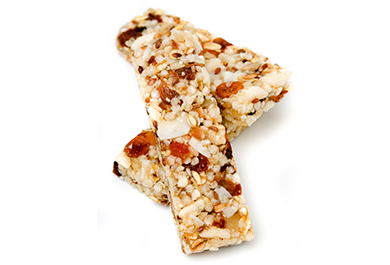Yes, under the right conditions. Ultrasonic cutting works very well for food products containing peanuts and nuts. With proper equipment settings and cutting methods, you get clean, fast, and repeatable cuts while reducing residue build-up on the blade.
Why Ultrasonic Cutting Excels with Hard Inclusions
- Clean cuts through inclusions
- Ultrasonic blades slice through hard inclusions (nuts, peanuts) without crushing or shifting them. This keeps the shape and distribution of pieces uniform within the product (e.g., nut bars, brownies, cakes).
- Less oily or sticky residue
- The vibration effect minimizes the build-up of oily or sugary residues (nut oils, caramel, chocolate), supporting continuous production.
- Low pressure = better presentation
- Because cutting requires very little force, the product keeps its shape and appearance, even with dense or delicate matrices.
- High repeatability in automation
- Ultrasonic systems integrate easily into robotic lines or conveyors, ensuring precise, high-throughput cutting.
Points to Watch and Potential Limitations
- Size and hardness of inclusions: Very large or hard nuts may require adjusting amplitude, frequency, cutting speed, and downforce for efficient results.
- Type of matrix: Very sticky or dense products (date paste with nuts, nougat, caramel) need optimized blade profiles and movement patterns (attack angle, trajectory).
- Hygiene and allergens: When working with allergens (peanuts/nuts), implement strict cleaning protocols and cross-contamination prevention in line with quality standards.
Key Parameters for Optimal Ultrasonic Cutting
- Amplitude and frequency: adjust based on hardness of inclusions and matrix density.
- Cutting speed: slow slightly when slicing through large or dense inclusions.
- Downforce: keep minimal—just enough for stability while preserving product appearance.
- Cutting angle and trajectory: a continuous or oscillating motion helps slice through dense nut clusters.
- Product temperature: working with slightly cooled products improves consistency and reduces sticking.
Regular blade
Ultrasonic blade
Best Practices in Ultrasonic Production
- Regular blade cleaning: schedule wipe-downs and, if possible, use CIP (Clean-in-Place) or clean water baths to reduce oily build-up.
- Temperature control: maintain stable product and blade temperatures for consistent results.
- Representative testing: validate settings on batches with the largest nut inclusions.
- Line synchronization: coordinate conveyors, robots, and blades (cadence, positioning) to ensure repeatability and efficiency.
Typical Ultrasonic Applications
- Nut and peanut bars
- Brownies and cakes with walnut or pecan inclusions
- Cheesecakes with nut crusts
- Nougat, torrone, and other nut-based confectionery
Frequently Asked Questions
Does ultrasonic cutting crush nuts?
No. With low pressure and the right settings, ultrasonic waves cut cleanly without moving or crushing inclusions.
What if the matrix is very sticky (dates, caramel)?
Optimize amplitude, reduce speed, adjust the cutting angle, and plan more frequent cleaning.
How to manage allergens (peanuts/nuts)?
Implement validated cleaning protocols and production sequences that minimize cross-contamination risks, in compliance with quality standards.
Are you considering ultrasonic cutting for products containing peanuts or nuts? Our experts can recommend the right configuration for your production needs. Contact us.

